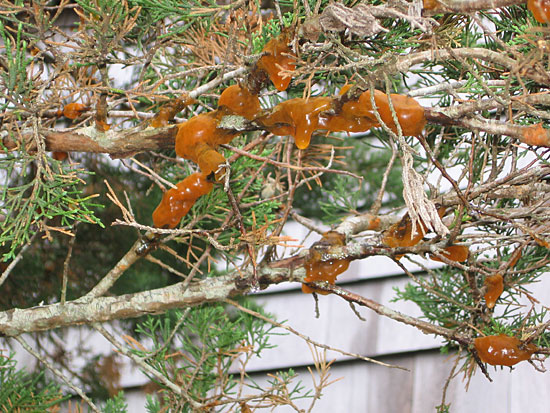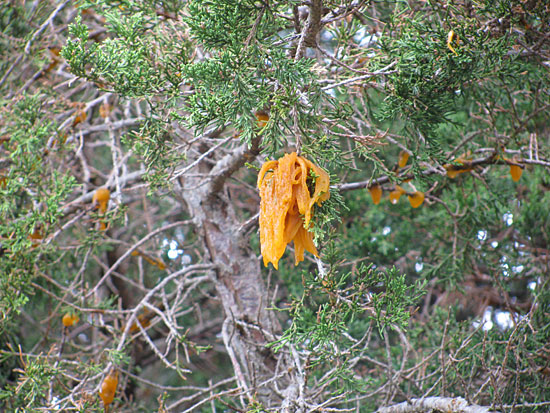Are the Orange Blobs Alien Life?
by Dr. Sarah D. Oktay
Managing Director UMass Boston Nantucket Field Station
There is a somewhat disgusting orange thing attached to many of the island’s red cedars that you may recognize. It looks like orange “Jello” stalactites draped from the trees. The pictures accompanying this article show it in all its spring/early summer glory. What you are seeing is commonly known as Cedar Apple Rust (CAR) which is an fungal species that affects apple and cedar trees in the Eastern U.S. and is caused by the plant pathogen Gymnosporangium juniperi-virginianae. It is the result of two species of plants being in close proximity, like two gangs that can’t exist in the same city without causing trouble. It can be a serious problem to areas where apple trees are cultivated and can easily be viewed at places like the Nantucket Field Station where apple trees were planted near our Eastern Red cedar. First, we’ll discuss a bit about the ubiquitous Eastern Red Cedar around the island and then investigate how CAR evolves throughout the spring and summer.
Juniperus virginiana (Eastern Redcedar, Red Cedar, Eastern Juniper, Red Juniper, Pencil Cedar) is a species of juniper native to eastern North America, from southeastern Canada to the Gulf of Mexico, east of the Great Plains. The name red cedar then, is a misnomer as this is a juniper, even though the plant has characteristics that many laypeople would consider being typical of cedars (like its red and fragrant wood often used for “red cedar” closet linings and chests). True cedars are those tree species in the genus Cedrus, family Pinaceae. Juniper berries are a spice used in a wide variety of culinary dishes and best known for the primary flavoring in gin (and responsible for gin's name, which is a shortening of the Dutch word for juniper, genever). Juniper berries are also used as the primary flavor in the liquor Jenever (ancestor of gin often linked to the term “Dutch courage” used by the British after imbibing it) and sahti-style of beers. Juniper berry sauce is a popular flavoring choice for quail, pheasant, veal, rabbit, venison and other meat dishes. Cedar waxwings love Juniper tree berries. They are salt, drought, and cold resistant and were used often as windbreaks in the prairie states. Eastern red Cedars are early colonizers and often move into areas cleared by American pioneers. The oldest living J. Virginiana according to Wikipedia was discovered in Missouri and found to be 795 years old. This is a very common plant on Nantucket, contributing to early spring allergy sufferers misery as their pollen spreads around the island.

Let’s return to the discussion of the horrible, diabolical, (if you are an apple or crab apple tree) orange blobs. The CAR fungus requires two hosts, apple and eastern red cedar (Juniperus virginiana L.), to complete its two year long life cycle. The term for this phenomenon is called a “heteroecious” life cycle from the Greek: “heteros:” or “other, different” and “oikia, oiko, oikos” for “house,” or literally (and helpfully) “different houses.” The primary host is the host in which the parasite spends its adult life; the other is the secondary host. In this case, the juniper is the primary (telial) host and the apple tree (Malus domestica) and crabapple (M. sylvestris and other Malus species) is the secondary (aecial) host. The CAR fungus overwinters in spherical galls on red cedar trees. These galls look a bit like reddish brown shriveled golf balls in their dormant stage. They are frequently bifurcated and hard to the touch, somewhat like a strange nut species. Some people even call these galls cedar apples, in an almost cruel twist of terms. You can see these galls all over trees across the island from late March to early May as they begin to “wake up” and become viable with rising temperatures and rainfall. At this point, they look somewhat like orange Christmas decorations, circular with little spikes. Spring rains cause horn-like structures, called telia, to extrude from the galls. When these horns absorb water, they become jelly-like and swollen. Between rains they dry to dark brown threads. The telial horns are comprised of thousands of two-celled spores called teliospores. Swelling and drying of telial horns may occur eight to ten times during the season. Each time, the horns push out further and expose more teliospores until the supply is exhausted. The galls may discharge up to two billion (with a B) spores throughout this drying /swelling lifestage.
During rains, after the telial horns absorb water, the teliospores germinate to produce a germ tube (basidium) from each cell. Four basidiospores are produced on each basidium. At optimum temperatures, basidiospores are produced within four hours of the horns absorbing water. Basidiospores are forcibly discharged into the air immediately after being formed. Kapow! They can be carried long distances; up to six miles have been recorded.

Basidiospores that land on young apple tissue may germinate and infect the tree if a film of water is present for an adequate amount of time. One to two weeks after infection, orange pustules (pycnia) containing pycniospores appear on the upper side of leaves or on the fruit of the apple. (Yum!) Before apple trees can be infected, adequate moisture must be present in a temperature range of 8-24 degrees C (46-75 degrees F) to allow for formation of basidiospores on cedar galls. Then, the basidiospores will infect apple when susceptible leaf and fruit tissues are wet for certain lengths of time at specific temperatures. Leaves are most susceptible to infection when they are very newly formed, within 4-8 days of age, and fruit are susceptible from tight cluster through bloom. The temperatures that this fungus likes are of course very typical temperatures found on the island, which combined with our wet weather, means that some years Nantucket can be a virtual “CAR”nival of linked apple tree-red cedar spore exchange (a cheap joke, I know, I couldn’t help myself).
Symptoms of infection on the apple and crabapple hosts are also quite colorful. Lesions first appear in early June as greenish-yellow spots that increase in size and develop a characteristic bright yellowish-orange color and are visible on both the upper and lower leaf surfaces. Occasionally, symptoms develop on fruit and twigs. By midsummer, minute "spore cups" called aecia develop at the edge of the lesions on the lower leaf surface. The spores (aeciospores ) produced in these cups are released from mid June until early October during dry conditions and are carried by wind and rain back to the Juniper/red cedar hosts where they complete the disease cycle. When these spores land, they germinate and stimulate the formation of galls, a process that takes from 19-22 months for completion. Because most galls produce teliospores for only one season (usually the second year after the infection), a new crop of galls is required each year if infection of apples is to occur.
A brief review (never know when there will be a test): You will find teliospores on cedars (the primary host), then pycniospores on apples (the secondary hosts), aeciospores form on apples, and those are deposited by wind back onto the cedar to create galls. All are stages of the same creature, but inhabiting different plant hosts at various times throughout their lives. The entire, very complex CAR disease life cycle can be found at the Cornell University web page www.nysipm.cornell.edu/factsheets/treefruit/diseases/car/car_cycle.asp
Cedar Apple Rust can defoliate trees and blemish fruit making them unmarketable. Treatment of CAR can go two routes, remove the red cedars near cultivated apple trees, or use fungicides. According to the Connecticut Agricultural experiment Station, sulfur can be used as an organic treatment method and they caution people that treatment using fungicides can be very difficult. Cedar Apple Rust is not lethal to either host, so most agricultural researchers and tree experts advocate removing the galls in the spring when possible and avoiding any more strenuous treatments.
Sellection and planting of resistant cultivars or varieties is the most effective means of control since this effectively reduces or eliminates the occurrence of the disease. Examples of resistant apple cultivars include Delicious, Empire, Jonamac, McIntosh, and Paulared. Resistant crabapples includeEllwangerina, Henry Kohankie, Ormiston Roy, and Red Baron. Resistant junipers are: Juniperus chinensis var. sargentii, J. communis cv. Aureospica, and J. virginiana cv. Tripartita. I hope you have enjoyed learning about this brilliantly colored denizen of the red cedar trees.
The majority of facts regarding CAR were obtained from several excellent papers reproduced on line, including: